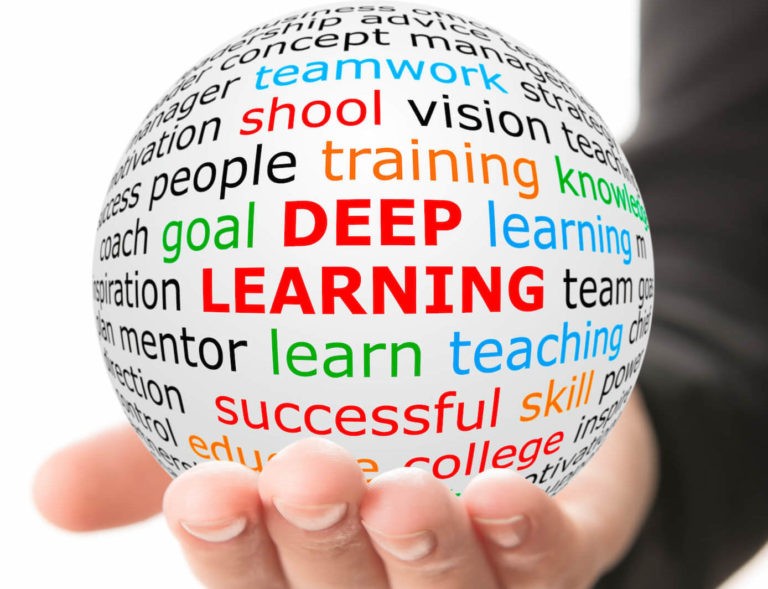What is Deep Learning?
When we learn, we gain new information and look at the world around us in a new way. Deep learning is learning that involves more higher level thinking skills, including the ability to analyze and synthesize information, solve problems, and think outside the box. In the process of Deep Learning, students are able to link information they already know with new principles so that their understandings can be used to problem solve when presented with new tasks. Once learners master Deep Learning, their learning process can be more autonomous as they understand how to reflect on their own learning and to make new connections on their own.
When encouraging Deep Learning, it’s important to keep the goal of content mastery in mind. Students who think deeply need to be able to solve real world problems and to connect ideas and apply knowledge across content areas. As students approach problems, they must be able to analyze those problems and develop a plan to solve them. Students who have the opportunity to work collaboratively are able to practice their communication and leadership skills while learning to think more critically about content than they would on their own. Deep Learning does not happen automatically for most. Learning to think deeply and learn deeply is a skill that can be sharpened more and more with practice.
Strategies for Deep Learning
There are many strategies to engage students in Deep Learning. These strategies are similar in that they ask students to engage in genuine learning experiences, make discoveries, problem solve, and think systematically. The following are strategies for Deep Learning that can be applied in the classroom in a wide variety of grade levels and across disciplines.
Create Units of Study that have BIG IDEAS
By creating larger units of study that revolve around “Big Ideas”, educators are giving students a reference point to refer back to so that they can keep the big picture in mind as they explore. For example, a teacher in 3rd grade may design a unit on Black History Month where students are to research notable African Americans. Students can have the choice in how they create a product that represents their learning, but will need to be able to reference the big ideas of the unit/research project.
Make Learning Personal and Relevant
By making learning relevant and personal, educators are peaking the interest of their students. Educators should stress that the content they are learning is important to them, important to the world they live in, and will be important for them to know in the future. This helps students realize the content is not just interesting but also worth learning.
Engage Students in Active Reading
Many students who struggle with reading are disengaged from learning. Active Reading allows students to be engaged in instructional practices and form connections with the content they are reading, in turn, creating more confident and successful readers and learners. Students often switch from a “Learning to Read” mindset to a “Reading to Learn” mindset around third grade. Applying Active Reading allows students to really think deeply about what they are reading and apply the knowledge they obtain from text to real world situations and use new information to problem solve. When students learn to stop and think about what they are reading, they are actively engaged in the reading process.
Utilize Essential Questions
Essential questions help educators give students a focus and purpose for learning. Many students ask themselves why they need to learn content. Essential questions help students make meaning out of subject matter and guide their learning. Essential questions to encourage deep thinking should be open ended, thought provoking, promote critical thinking, raise additional questions and spark curiosity.
Encourage Collaboration
Perhaps one of the most important strategies in encouraging students to think deeply is to allow them to collaborate with their peers. Many times when students are able to bounce ideas off of one another, they begin to form new understandings and perspectives regarding content. When helping students develop their deep thinking skills, collaboration is key! When working with others, students have the opportunity to strengthen their communication skills and listening skills. They also gain an understanding of the different perspectives and experiences of others.
Ask Questions
Critical thinking occurs when educators know the right questions to ask. Students need questions that get their minds thinking about things they have never pondered before. As Ken Bain said, “One of the great secrets of fostering deep learning is the ability to help students raise new kinds of questions that they will find fascinating” (Right Question Institute, 2021).
When educators are planning and implementing lessons that encourage and promote Deep Learning, they are essentially teaching students how to learn. As students learn how to learn, they are developing the ability to self-direct and to drive their own exploration. With support form teachers, students can set their own goals, track their progress, reflect on their learning and grow! By learning to think deeply, students are becoming life-long learners who make learning and priority. Eventually, thinking deeply will become a natural part of the learning process for these students. Through deeper learning and thinking, educators are able to build strong foundations for students. This foundation will prove to be beneficial to students as they move into secondary learning, college, and even career opportunities. It is vital that teachers have the resources they need to increase student capacity for thinking deeply.




